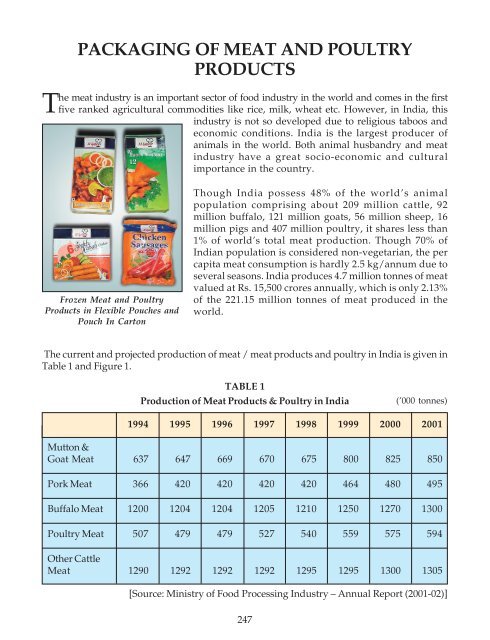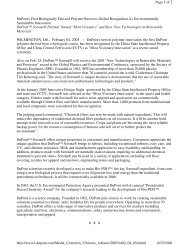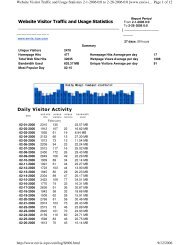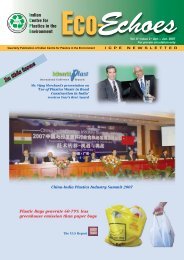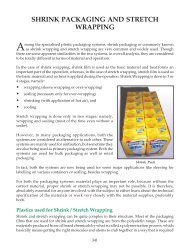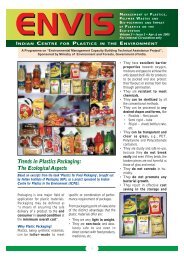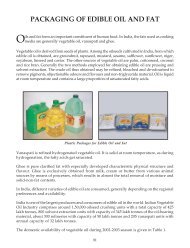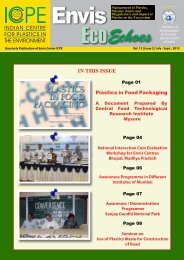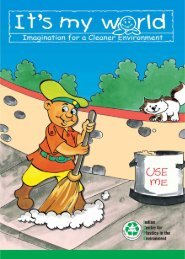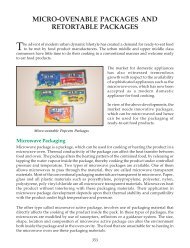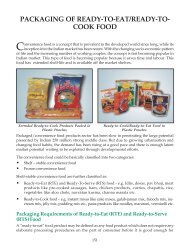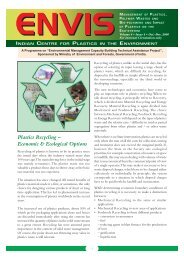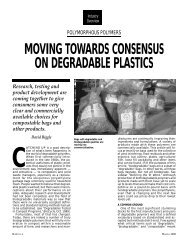PACKAGING OF MEAT AND POULTRY PRODUCTS - ICPE
PACKAGING OF MEAT AND POULTRY PRODUCTS - ICPE
PACKAGING OF MEAT AND POULTRY PRODUCTS - ICPE
Create successful ePaper yourself
Turn your PDF publications into a flip-book with our unique Google optimized e-Paper software.
as near as possible to –1°C, which is the lowest temperature at which meat can be storedwithout freezing it.• Shrink Packaging: Plastic Shrink films are used for wrapping large and uneven cuts offresh meat. It is a technique in which heat shrinkable polymer film is shrunk around themeat product by application of heat to achieve a skin-tight and compact pack. The packagingfilm should have structural strength. It should be a good water vapour barrier and becapable of withstanding storage temperature of about – 45°C.The advantages of plastic shrink film include neat appearance, ease in handling and acontour fit. Hot tunnels are used to effect a tight wrap. Heat shrinkable polyvinyl chloride,polypropylene, irradiated polyethylene PVDC and rubber hydrochloride are used to shrinkwrap fresh meat.• Vacuum Packaging: This technique is used for packaging of primal and sub-primal cuts ofbuffalo meat. In vacuum packaging, theproduct is filled in a bag/pouch, air iswithdrawn either by nozzle vacuuming orby chamber vacuuming and the bag/pouchis heat sealed thus storing the product inan air free environment. The plastic filmused for vacuum packaging must have ahigh resistance to gases and water vapourwith perfect seals and good mechanicalstrength. Since vacuum packagingprovides a barrier to the product fromoxygen and moisture, it is suitable for aperiod of 3 weeks. The most commonlyPlastic Pouches for Vacuum PackedPoultry Productsused film for fresh meat vacuum packaging is PVDC (poly vinylidene chloride). It offers lowoxygen permeability and shrink characteristics so that large cuts can be kept for up to 21days with minimum loss of moisture. Typical packaging materials used are:• Polyethylene / co-polymer coated cellulose film laminates• Polyester / polyethylene film laminates• Polyamide / polyethylene laminatesThese are usually used as sachets with PE inside to promote efficient heat seals• Laminates of plastic film with aluminium foil• PVDC co-polymer films• EVA / Saran / EVA laminates• Nylon / EVA / laminates• PVDC / Polyester / PVDC / PE laminates• LDPE / BA / nylon / BA / LDPEVacuum packaging is more a means of keeping meat at better level of quality than the meansof increasing shelf-life, because it is virtually impossible to remove all the oxygen (small251
quantities remain trapped within the product). Also, some anaerobic organisms, which arenot affected by oxygen are not reduced.A shelf-life of up to three weeks for fresh meat is achieved by vacuum packaging, but it is notpopular at retail level because of purple red colour of meat. During the period of threeweeks, the enzymes in the meat continue the process of tenderising. At the end of thestorage period the meat blooms. Vacuum packaging ensures a life of 8-10 weeks at 0°C forbuffalo meat. Lamb and pork have a short life as compared to beef. Lamb has higher pHwhile pork has higher initial load of bacteria. However, vacuum packaged boneless jointsare reported to have a shelf-life of 2 weeks at 1°C.Vacuum packaging in cryovac barrier bags is also used for storage and transport of freshmeat products.• Skin Packaging: Another development that offers advantages for presentation as wellas packaging design variety is skin packaging. The process allows the packaging filmto conform exactly to the profile of the product. This gives rise to many opportunitiesfor enhanced product presentation as well as further improving the integrity of thepack itself. In a skin pack, the product becomes the die for the thermoform packagingoperation. The semi-rigid bottom web may or may not be thermoformed. The top webis heated in an evacuating chamber until it is near its melting point, at which it drapesover the product and forms a skin around all the contours. Upon sealing andcooking, it retains its new shape, ensuring intimate contact with the product,irrespective of surface irregularities. Skin packs are prepared with an oxygen barrierplastic film.• Modified Atmosphere Packaging: The use of MAP technology in meat industry has shownincreasing trend during the past decade. MAP extends the shelf-life of meat and meatproducts under refrigerated storage and maintains, colour, texture and flavour of theproduct for a considerably longer time in flexible plastic films. Application of MAPimproves shelf-life of raw chilled meat with reference to colour, delaying bacterial spoilageand minimising exudate loss.Meat requires different conditions for packaging, beef needs high oxygen content to maintaina bright brick-red colour. Chicken needs little oxygen and reduced amount of carbon dioxide.Pork with its high fat content needs less oxygen and some nitrogen for glow.MAP involves placing fresh meat in an environment in which the oxygen availability isaltered from that in the air. This is commonly done either through the removal of air/oxygen by vacuum and then back flushing with carbon dioxide, nitrogen or a combinationof the two. Carbon dioxide inhibits the growth of typical aerobic meat spoilage microorganisms.Carbon dioxide also inhibits mold growth, but the same is true for completenitrogen flush and vacuum packaging in which the oxygen is almost totally removed. Inall three processes, low oxygen availability atmosphere are created, inhibiting aerobic meatspoilage organisms. It has been reported that, in general, the use of 20% carbon dioxideand 80% oxygen is a good proportion with respect to balancing the attractive meat colourand retarding the bacterial growth thus extending the shelf-life. A mixture of 70% oxygen,252
20% carbon dioxide and 10% nitrogen at 0°C slows bacterial growth so significantly thatmicrobially caused discolouration, sliminess and aroma changes are eliminated. A mixtureof 80% carbon dioxide and 20% nitrogen is better bacteriostatically, although somecolour loss occurs. Fresh pork in 10% carbon dioxide can be stored for a period of 40 daysat 4°C.Similarly, the blends of gases containing 90% carbon dioxide and 10% nitrogen; 85% carbondioxide and 15% nitrogen are equally effective in providing packages with good colour retention,good bacterial check and good product and package appearance. The typical gas mixtures usedfor some of the meat products are given in Table 2.TABLE 2Typical Gas Mixtures used for some of the Meat ProductsProduct Temperature in °C O 2% CO 2% N 2%Fresh Meat 0 – 2 70 20 10Cured Meat 1 – 2 0 30 70Pork 0 – 2 80 20 0Poultry 0 – 2 0 20 - 40 80 - 60Changes in meat, fish and poultry as brought about by modified atmosphere are given inTable 3.TABLE 3Changes in Meat, Fish and Poultry as brought about by Modified AtmosphereChangesEnzymatic ageing processMicrobial spoilageFat oxidationOxidation of myoglobinResultsunaffectedincreased CO 2reduces growth of aerobic spoilageorganisms by penetrating membranes and loweringintracellular pHreduced O 2reduces oxidation of fats, although oxidationcan still occur at low O 2tensionsincreased CO 2promotes metamyoglobin formation andcolour darkening.For these types of packages, the packaging film should have good gas barrier and sealabilityproperties and have optimum clarity and antifogging properties so that packs maintain theirclear appeal in or out of the chill display. For most MAP applications, conventional multilayer,high barrier films are used. The various types of packaging films used for MAP of differentmeat products are given in Table 4.253
TABLE 4Plastic Packaging Films used for MA Packed Meat ProductsTypes of Film/Packaging StructureProductCurlon 863 (Nylon/Curpolymer-surlyn)Nylon – Polyester Vacuum bags B 540, Cryovac, W.R. GraceSaran coated PVC bagsPA80/PE 100-PE 100/PA80/PE 100Mylothene 12/80/5PETP/X/PE/X, 12/5/70/5 laminated plastic bagsThermoformed plastic pouches (lower part PVC/PE, 250/70and cover PETP/X/PE, 12/5/70)Cryovac barrier bagsFoil laminate pouchesbeef rib eyerolls of 1” thickground beefbeef strip loinssmoked pork loinsausagesfresh pork chopsprocessed hamground beef pattiesboneless pork loinTo attain shelf-life extension in packaging and distribution of fresh meat in MAP, it is veryimportant that temperature be maintained as near to 0°C as possible. As compared to vacuumpacks, gas packed products have a better appearance but have a comparatively shorter life.These packages also require more space during storage and use more packaging material. Invacuum packs, since the drip loss is negligible, higher shelf-life can be attained. Thedisadvantages of vacuum packs are the unattractive purple colour of the meat and the problemsof packaging meat cuts with bones, which can pierce through the film.Packaging of Frozen MeatMajor portion of exports of meat from India is in frozen form. Preservation of meat by freezing,offers the greatest advantages of increase in shelf-life, inhibition of bacterial growth andpreservation of fresh texture and flavour. If frozen meat is not properly packed there is continuosdehydration from the surface resulting in freezer burn. This condition affects the surface textureand colour. Meat fat is also prone to the development of oxidative rancidity if a good oxygenbarrier is not used. Hence, frozen meat needs protection against:• Dehydration and loss of surface texture• Moisture loss• Temperature fluctuations• Rancidification• Pick up of odours / flavours• Expansion and contractions which occur during freezing and thawing254
Packaging RequirementsA suitable packaging material must, therefore, have a very low moisture vapour and oxygentransmission rate. The material should also be durable at freezer temperature, have very highwet strength and be impermeable to odour and flavours.Packaging MaterialsPlastics are amongst the most commonly used materials for packaging of frozen meat Generally,low density polyethylene (150 - 200 gauge) is used for this purpose as it provides adequateclarity and is stable at low temperatures and is available at low cost. Polyester or Nylon / PElaminates and heat shrinkable low density polyethylene and PVC / PVDC co-polymer filmsalso provide functional properties, besides giving neat appearance to the frozen meat cuts.Shrink packaging also allows convenient handling of the product.Frozen meat may be in the form of chunks, minced or various cuts. The unit packs consist of 1,2,4or 8 lbs in LDPE bags of 250 - 350 gauge. After placing the meat in the bags, the bags is foldedand then the packed product is blast frozen at - 40°C for a period of 4 to 12 hrs depending uponthe size and shape of the package. After freezing, unit packages are packed and stored incorrugated boxes made of either paper or plastic, which are either waxed internally, or on boththe surfaces. These boxes are stored at -20°C and the expected shelf-life for the product is aroundone year.Packaging of Cured MeatCured meat like ham, bacon, luncheon meat and frankfurters have a shelf-life of 12-15 days at4°C depending upon the degree of curing. The attractive pink colour present in cured meat isdue to a pigment called nitrosomyoglobin. Although this enzyme is more stable thanoxymyoglobin, it is readily oxidised to metamyglobin. The colour of the meat can fade due to theaction of light.Packaging RequirementsThe role of package for cured meat is to minimise light fading by preventing the entry of oxygenand loss of moisture. The spoilage due togrowth of bacteria and yeast is expected to bereduced by freezing or refrigeration. Thepackage must be able to withstand low storagetemperatures and also present an attractiveappearance. The packaging material should bea good oxygen and water vapour barrier. Itshould be flexible enough to make a closesurface contact with meat. The packaging filmshould be capable of lamination or co-extrusionand hermetical sealing.Packaging Materials• Over wrapping: Short-term storage of cured meats can be done by over wrapping theproduct with polyethylene. Some other films like Poly Vinyl Chloride (PVC)255Meat and Poultry Products Packed inLaminated Plastic Pouches
Polyvinylidene Chloride (PVDC) provide tight fitting over-wraps. Aluminium foil/paperlaminate can protect the cured meats against light. Another type of package called thechub pack is used for some ground products. Chub packs are tubes stuffed with softproducts which is twist tied or clipped at each end. The packaging film used for chubpacks is generally polyethylene.• Shrink Packaging: Ham and other large irregular cuts of meats are packed in shrinkablePVDC/PVC co-polymer films where the air is evacuated and the contour is over wrappedeither by immersing in hot water (90 - 95°C) or passing through hot air tunnel to effect theshrink.• Vacuum Packaging: For long term storage of bacon blocks, luncheon meat etc.vacuum packaging is the right choice. This technique assures a shelf-life of 5 months at4°C and 6 - 8 months at –18°C. The following laminates are used for vacuumpackaging:• Cellophane / PVDC / LDPE• Polyester / PVDC / LDPE• Polyamide / PVDC / LDPE• Metallised Polyamide / Ethyl vinyl acetate (EVA)• EVA / PVDC / EVA• Polyamide / LDPE / ionomer• PVC / PVDC / LDPE is used for packing sliced luncheon meat.In all the above cases, plastics provide a wide range of packaging solutions.Packaging of Thermo-processed / Cooked MeatMost cooked meat are canned and have a long shelf-life of over two years. Thermal processingis usually done above 100°C by applying pressure. Generally, hermetically sealed rectangulartinplate containers with easy open devices are used.Meat products like patties, sausages, nuggets and meat balls are packaged in pouches madeof polyethylene, polypropylene, PVDC, rubber hydrochloride etc. for short term storage testingfor 10-12 days at 4°C.Products like corned beef, corned pork, meat gravies, meat soups, liver sausages, chickencurry, boneless chicken etc. are hermetically sealed and cooked to make commerciallysterile for long term storage at room temperature. Metal containers are used for thispurpose. Canned meat products are shelf-stable for a number of years at roomtemperatures. Tinplate is mostly used to pack these products. They are coated on the innerside with sulphur - resistant lacquer. Shallow drawn aluminium cans with internal lacquerare also used to pack some products.Packaging of Dehydrated MeatDehydration is a successful means of preserving many meat products with properpackaging because they are highly susceptible to oxidation resulting in rancid odour. The256
packaging materials used are tinplate cans. Metal foil / plastic film laminates are used topack compressed bars of dehydrated minced meat with inner cellophane and outer paper /aluminum foil / PE laminate. This pack is said to be shelf-stable for one year. Flexiblepouches suitable for vacuum and modified atmosphere packages made from polyester /PE / Aluminium foil / PE or cellophane / PE / Aluminium foil / PE laminates are alsoused.Packaging of Meat ProductsVarious meat products like sausages,frankfurters, luncheon meat, corned beef,cooked ham, bacon, meat pies etc., are madefrom comminuted and seasoned meatblended with various cereals, binders, spicesand preservatives. Their packagingrequirements are similar to fresh meat suchas trays and films, shrink film bags,envelopes and pouches.Pouch-in-Carton for Ready-to-Cook Packaging MaterialsPoultry ProductsSome varieties of smoked products such assausages, salami, frankfurters are vacuum packed in pouches with or without trays or cardboard inserts. Sliced meat products like ham, bacon are loosely packed in a pouch or theyare singled or stacked and vacuum packed. Some products like chicken leg masala, chickenin-curry,meat-in-brine etc are packed in metal cans. The laminates used for vacuumpackaging are combinations of cellophane / PVDC / polyethylene or polyester / PVDC /polyethylene. Some plastic films can be drawn into cavities, which make neat package forslices. These packages are made from combinations of polyethylene / PVDC / polyamide orpolyester.Packaging of PoultryPoultry meat is high in protein, low in calories and easy to chew and digest, but poultry fatis unsaturated and is very prone to the development of oxidative rancidity. Shelf-life ofpoultry varies according to type of processing, nature of processing environment, initialflora and post-slaughter treatment.Packaging of poultry meat is undertakenimmediately after the dressing operations areover. Unpacked refrigerated storage mayresult in surface dehydration, freezer burn,characterised by surface dis-colouration,tough texture and diminished juiciness aswell as flavour loss. Poultry is usuallypacked as whole dressed poultry, cut uppoultry and poultry organs. Dressed poultryChilled and Frozen Poultry Products in FlexiblePlastic Pouches and Termoformed Plastic Tray257have a shelf-life of 5-7 days at refrigeratedstorage conditions of 0-5°C.
Packaging Materials• Over-wraps: Packaging of whole dressed chicken halves or cut-up parts are done inplastic films like polyethylene, polypropylene, PVDC, rubber hydrochloride or nylon-6. These are films of 150 to 200 gauge in thickness. Polyethylene is the most widelyused packaging material in our country because of low cost and easy availability.These thermoplastic film sheets can be fabricated into bags. Each dressed evisceratedbird is inserted into a bag. Gilblet of individual bird is wrapped in waxed paper orparchment paper and placed into the body cavity before bagging. The problem ofbody fluid accumulation is avoided by putting an absorbent pad or blotter on thepack of each bird to soak up the liquid. The bag is then heat sealed or twist-tied orclipped shut.• Tray With Over-wraps: Small whole dressed chicken, broilers, roasting chickens areplaced in a polystyrene foam tray and over-wrapped with transparent plastic film. Ablotter underneath absorbs the excessive meat juice accumulated. Chicken thuswrapped has a shelf-life of 7 days at 4°C in refrigerator.• Shrink Film Over-wraps: Many thermoplastic films such as polyethylene,polypropylene, poly vinylidene can be biaxially oriented to stay stretched at ambienttemperature. Dressed chicken is overwrappedwith such films and passedthrough hot air tunnel or dipped in watertub maintained at 90°C for a few secondsto effect shrinkage of the film.• Vacuum Packaging: The ideal materialsfor vacuum packaging of poultry arelaminates of polyester / polyethylene(PE), polyamide / polyethylene, PVDCco-polymer film, nylon/ EVA.Dressed Chicken Packed in Plastic Pouches• Modified Atmosphere Packaging: Inthis technique, the atmosphere surrounding the product in the pack is modified byflushing carbon dioxide, nitrogen and oxygen alone or in combination. Mixture of 60%nitrogen and 40% carbon dioxide or 50% nitrogen and 50% carbon dioxide is ideal formodified atmosphere packaging of chicken meat.Modern Trends in Meat and Poultry PackagingWith the development of new meat products entering the market, high quality alternative packagingmaterials are also emerging. The consumer is becoming more discerning in his or her choice offood products and there is a trend, which shows a shift from traditional food items and eatinghabits. Some of the recent trends in the meat packaging industry are covered here.Retortable Flexible PouchA retort pouch can be defined as a flexible package into which a food product is placed,sealed and then sterilized at temperatures between 110°C to 140°C. The finished productis commercially sterile, shelf-stable and does not require refrigeration. A retortable pouch258
is made of a laminate of three layers held together by adhesive. The outer layer made ofpolyester, polyamide or oriented polypropylene provides support and physical strength to thecomposite.The middle layer of aluminium foil acts as a barrier against water vapour, gases and light. Theinner layer of polyethylene, polypropylene or PVC provides heat sealability and food contact.The different laminates used for a retort pouch are polyester / aluminium foil / modifiedhigh-density polyethylene or polyester / aluminium foil / polypropylene-ethylene co-polymer.A retortable pouch like the metal can, can be sterilised by heat and it has the advantage oflower cooking time as it has a thinner profile than metal cans. They are not required to bestored at refrigerator temperatures and are shelf-stable, as canned food. Also, these types ofpackages require less storage space and are lighter in weight as well.Roast-in-bagsIt is an oven stable vacuum skin package that can be used to cook meat at a temperature up to204°C. It is fabricated from polyethylene terephthalate (PET) film due to its unusual propertiessuch as it does not become brittle with age, has long shelf-life, has resistance to most chemicalsand moisture and is dimensionally stable.Microwave PackagesConvenience food fall into two categories, frozen and retortable. The current trend in frozenfood is dual oven-ability i.e. products that can be heated in a microwave oven and conventionaloven. Shelf-stable retortable food are better suited to microwave heating. Owing to the growingimportance of microwave ovens, other materials are overtaking the conventional aluminiumtrays.While selecting thermoplastics for dual ovenable packages, the critical properties to beconsidered are dimensional stability up to 200 ° C to 250 ° C, good impact strength at freezertemperatures and microwavability. Heat resistant plastic trays made from materials likepolyester, polypropylene, nylon and polycarbonate can be used in combination or asmonolayers. These trays are closed with heat-sealable lidding materials or over-wrapped orshrink wrapped or sealed inside a microwave bag. Thus, due to their flexibility of formingdifferent shapes and sizes on in-line formation, rigid plastic trays dominate the microwavablepackaging.Polyester coated paperboard cartons are also used as microwave packages. These containerscan be formed on a conventional tray making, carton forming and folding carton makingmachine. Crystallized polyester containers are also very popular for microwave packaging aswell as for conventional oven cooking. These trays are very stiff and can be sealed in a highspeedtray sealing machine with transparent or non transparent lidding material. They areeasy to handle, sturdy, attractive, cost competent and can be compartmentalised for multicomponentfood items. They are self-serving and reusable.Cryovac PackagesPre-cooked meat packages with shrink film are an innovation with equipment made andsupplied by Cryovac. In this system, there is a double chamber machine. In the longer chamberthe meat is placed in the film bag and the mouth of the bag is drawn into the smaller chamber.259
In the longer chamber a low level of vacuum is just drawn to balloon the bag in order toeliminate formation of air pockets.A high level of vacuum is then drawn into the smaller chamber where the mouth of the bag isplaced. When both the chambers are at maximum vacuum, an automatic clipper closes thebag. The packaged meat is then sent to the shrink tunnel. Cryovac package forms a skin tightpackage. This together with the use of a film with low oxygen permeability stabilises theproduct and increases the shelf-life.Studies Conducted at IIPShelf-life studies of some meat and poultry products were carried out at the Institute,using modified atmosphere packaging technology. The products considered for the studywere:• Chilled minced meat• Salami• Sausages• Ready-to-cook chicken products (chicken drumsticks)The shelf-life studies were carried out at refrigerated storage conditions of 0°C to 5°C. Theproducts were packed by three different packaging systems viz.:• Ordinarily packed• Vacuum packed• Gas flushedThe packaging materials used were:1) 10µ PET / 45µ HDPE – LDPE – Co-extended2) LDPE – BA – Nylon – BA – LLDPE3) HDPE – LDPE – HDPE4) HDPE – LLDPE5) HDPE + LDPE ( Blended)100% Carbon dioxide was used for making gas flushed pouches.Chilled meat and ready to cook chicken drumsticks were packed in material 1 and 2 byordinary and vacuum packaging method. Salami and sausages were packed in materials1 and 2 by all the three methods viz. Ordinary, Vacuum and Gas flushing. Materials 3,4and 5 were used to pack chilled minced meat, salami & sausages by ordinary methodonly.The shelf-life of the meat and poultry products in different packaging materials is given inTable 5. The results of the study indicate that vacuum packaging gives a better shelf-lifefor processed meat products as compared to ordinary/gas packaging.260
TABLE 5Shelf- life of the Meat and Meat Products in Different Types of PacksMaterial Chilled Minced Salami Sausages R.T.C. ChickenMeatDrumsticksOrdi- Vacu- Ordi- Vacu- Gas Ordi- Vacu- Gas Ordi- Vacunaryum nary um nary um nary umPack Pack Pack Pack Pack Pack Pack Pack10µ PET 3 4 16 28 28 18 63 24 12 2845µ HD - LD days days days days days days days days days weeksCo - extLDPE - BA - 4 7 20 35 35 19 63 24 14 31Nylon - BA days days days days days days days days days weeks- LLDPEHDPE - LD - 2 – 15 – – 18 – – – –HDPE days – days – – daysHDPE / LLDPE 2 – 15 – – 18 – – – –days – days – – daysHDPE + LLDPE 2 – 15 – – 18 – – – –days – days – – daysConclusionWith continually growing demand for processed, packed, convenient ready-to-eat and readyto-servemeat products, a variety of specialised package profiles are available depending onthe type of processing techniques and storage conditions. From fresh meat to cured meat,from pork to poultry, the purpose of packaging is mainly to make the products available to thecustomers in the most attractive form along with maintaining the quality of the contents. Plasticsare used in every form of packaging like trays, overwraps, shrink films, MAP and retortpackaging. Plastics in the form of laminates, plain films, overwraps or retorts play a majorrole in imparting barrier properties and aesthetics to the packaging media. All in all, the use ofplastics in meat and poultry packaging acts as one of the most important factors in the growthof food processing industry today.References1. Modern Food Packaging, Developments in Modified Atmosphere Package of Meat, Poultry &Fish2. Indian Food Industry, Vol. 20, No. 3, May–Jun ’01, Modern Trends in Packaging of Meat andPoultry3. Processed Food Industry, Sep 2000, Meat Industry in India and Other Developing Countries4. Indian Food Industry, Vol II (I), Jan–Feb ‘92, Poultry and Meat Processing Industry261


